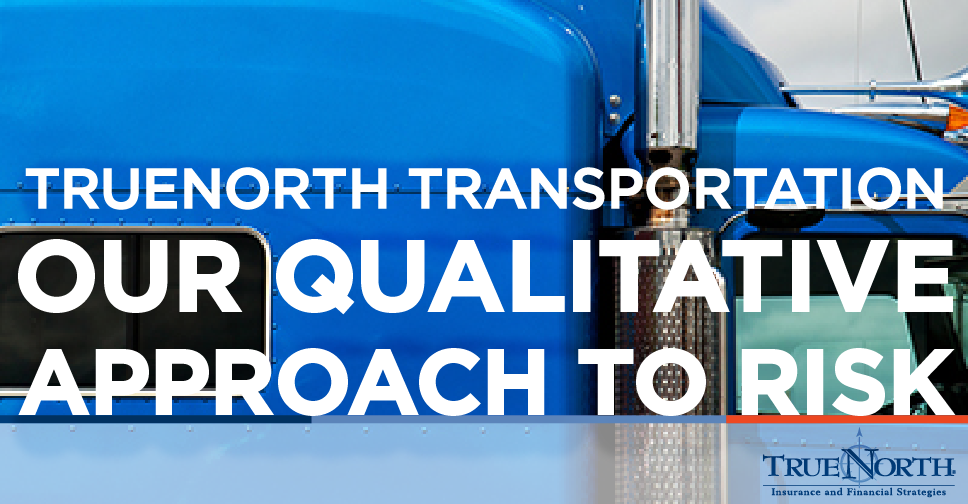A Qualitative Approach to Risk
posted by TrueNorth Transportation on Friday, March 20, 2020

With 30-80% of a motor carrier’s Total Cost of Risk (TCOR) coming from variable and indirect costs, the approach to a solid and successful strategic risk-financing and risk-mitigation program must begin with two essential factors: qualitative and quantitative.
The larger the fleet, the more risk is generally retained, and therefore funded out of the operating accounts of the business. The variable (controllable) portion of a fleet’s TCOR can be as high as 80% in large fleets, where a significant amount of risk is retained. That said, when you look beyond deductibles to include lost productivity and revenue; decreased asset utilization; customer bad will; the recruiting, hiring and training of new employees; the retraining of a driver; additional administrative costs; wages for an injured driver; future impact on AL and WC premium; and investigation cost, clean-up cost, additional supervision, internal maintenance and repair costs – variable cost can be substantial for even small fleets.
The quantitative approach (which will be tackled in next quarter’s article) is comprised of (1) historical losses, (2) appetite for assumed risk and (3) risk transfer or the purchase of insurance (fixed cost). When considering the ideal quantitative strategic risk financing position, there are several options. Ultimately, as we continue to conduct business in the golden age of nuclear verdicts, your insurance purchase should ensure business continuity.
From a financial and program control perspective, Guaranteed Cost Insurance lacks sophistication and allows little room for creativity or flexibility. This is a typical insurance purchase with little or no deductibles, which entrusts the insurance company with program management. Unfortunately, this may also be the only option for small fleets or those lacking necessary elements of risk control.
Deductible and Self-Insured Retention (SIR) programs fall higher along the range of risk financing alternatives because they allow the company more flexibility to establish an appropriate level of assumed risk based on tolerance. The highest level of program control for motor carriers lies in the single-parent captive and self-insured trust. With these plans, loss stratifications and credible actuarial assessments set the tone for decision-making and help companies determine ideal levels of program and financial control. In the golden age of nuclear verdicts, viewing risk management as an insurance purchasing activity no longer going to ensure business continuity.
The qualitative approach to lowering cost of risk.
TrueNorth has yet to encounter a transportation or logistics company with an overstaffed risk and safety department. Most run understaffed and inefficient. Your insurance partners (brokers and insurance companies) should be expected to partner with, assist and supplement your resources. The qualitative approach is designed to lower the TCOR through mitigation and controls in three areas: culture, technology and communication.
CULTURE
Safety begins and ends with company culture, period. It is not enough to just have policies and processes in place and to just talk about it; your executive and management teams must embody a safe culture each and every day in each and everything that you do. Each and every program and policy within the company must be created and implemented with safety in mind. Each and every action and process must be performed with safety in mind. You must truly believe and live it in order to influence your staff and drivers and their behaviors.
Safety culture must begin in the C-Suite with no exception. If ownership and management do not live the initiatives and the culture that are being promoted within the organization, it is reasonable to expect that no one will. “If it’s not important to the boss, it’s not important to anyone,” and that becomes the culture. More importantly, when staff and drivers see the company leaders living the safety initiatives and culture being promoted, they are likely to follow and work to get better and that becomes the culture. Simply put, your culture is your values minus what you allow.
TECHNOLOGY
The goal of any technology is to assist organizations in gaining greater insight into their business in order to be more efficient and effective with time and resources. Technology has transformed the transportation industry in a dramatic manner over the past 10-15 years and will continue to do so in the foreseeable future. Looking at how to make an impact on and improve your risk program, there are two technologies that will give you the greatest return: Risk Management Information Systems and In-Cab technology.
Risk Management Information Systems
Many transportation companies today are still operating legacy platforms to conduct and manage middle-market and large-capitalization companies. Most of these systems are reactive in nature and are ineffective at identifying trends, opportunities and deploying resources when and where needed. In today’s environment, the management of data is key to the success of any risk and safety effort regardless of an organization’s size. All motor carriers need is a system to accurately identifies, documents, tracks and manages risk and claim information.
A good RMIS system, where you can accurately track and manage your data, is a critical part of reducing the cost and frequency of claims and crashes. Fleets must truly understand what is happening within the business in order to affect change. Key performance indicators (KPI’s) must be established in order to monitor risk-related finances and claim frequency. The KPIs also need to identify SBUs (specific fleets, specific dispatchers/managers, specific terminals and locations, specific customers) within the organization so that you can direct the limited resources available where needed. Having a good RMIS in place allows organizations to better identify problems and deploy resources accordingly – a proactive data-driven approach can ensure favorable renewal outcomes, as well.
Onboard and In-Cab
Other important tools that support a successful motor carrier risk management program are the use of in-cab and onboard safety technologies such as event recorders (cameras) and collision-avoidance systems
Event recorders allow the fleet to identify driver behaviors that need to be addressed either by rewarding or coaching when needed. As important as identifying and coaching driver behavior, event recorders can also assist motor carriers in quickly determining crash causes and liability. The documented video evidence will expedite the settlement process. Cameras also combat insurance fraud and fraudulent claims by being able to clearly identify the cause and liable party. Most event recorders will start to record when motion is detected so it can also protect the asset when unoccupied.
Collision-avoidance systems will alert the driver to a potential hazard or collision. This allows the driver to take the required action to avoid the hazard. Some collision-avoidance systems will take over the steering, speed and braking of the power unit in order to avoid a collision.
All of the systems can be installed by the OEM or purchased aftermarket and retrofitted. Both technologies are proven to return positive results when administered and monitored properly by the fleet.
In order to be successful with any technology, it is crucial that these systems are not just purchased and installed. They must be evaluated, deployed and managed as part of an overall risk management program that supports the company culture.
COMMUNICATIONS
An occasional QUALCOMM message, email or text and a break room covered in 25 different safety posters is not a good communication strategy. And yet, this is common in many motor carriers today.
Effective and frequent communication with front-line employees is important in any organization. But in a transportation company, given that those front-line employees are remote and rarely seen face to face, communication becomes critical to your success. How and what you communicate is the most essential part of your organization. Purposeful messaging throughout an organization is critical to the operation and will drastically impact safe culture adoption. Implementing a solid communication strategy will support your internal culture, driver retention and safety programs.
A successful strategy includes regular contact and feedback to staff and drivers. In order to effect change, there needs to be set goals and expectations. These goals and expectations must then be communicated to all, performance must be monitored and then feedback must be given on a regular basis. If any of these steps are missed, the goal of effecting positive change will become more difficult to attain.
A ROBUST APPROACH
Investing in a robust risk finance and mitigation strategy can help transportation and logistics companies establish business continuity and in turn enjoy better outcomes in the insurance marketplace. An insurance purchase should be more than an uncontrolled or forced annual transaction. The qualitative measures outlined above can help motor carriers understand changes to their risk profile and better contemplate their risk-bearing capacity.
By leveraging data and staying privy to new risk financing opportunities, transportation executives can feel equipped to make strategic decisions that add value to their organization’s balance sheet.
All this to say, motor carriers can better understand changes in their risk profile and risk-bearing capacity by considering an approach to risk management that focuses heavily on the qualitative factors. Progress, not perfection, is the goal.

Vice President, Transportation Risk Solutions

Transportation Risk Specialist
A print-friendly version available here.
This publication has been prepared by TrueNorth Companies, L.C.’s Transportation division and is intended for informational purposes only. Transmission of this publication is not intended to create, and receipt does not constitute, a client relationship with TrueNorth Companies, L.C. This publication does not constitute any type of representation or warranty, and does not constitute, and should not be relied upon as, legal advice. This publication is not a contract and does not amend, modify or change any insurance policy you may have with an insurance carrier. © 2020 TrueNorth Companies, L.C. All rights reserved.